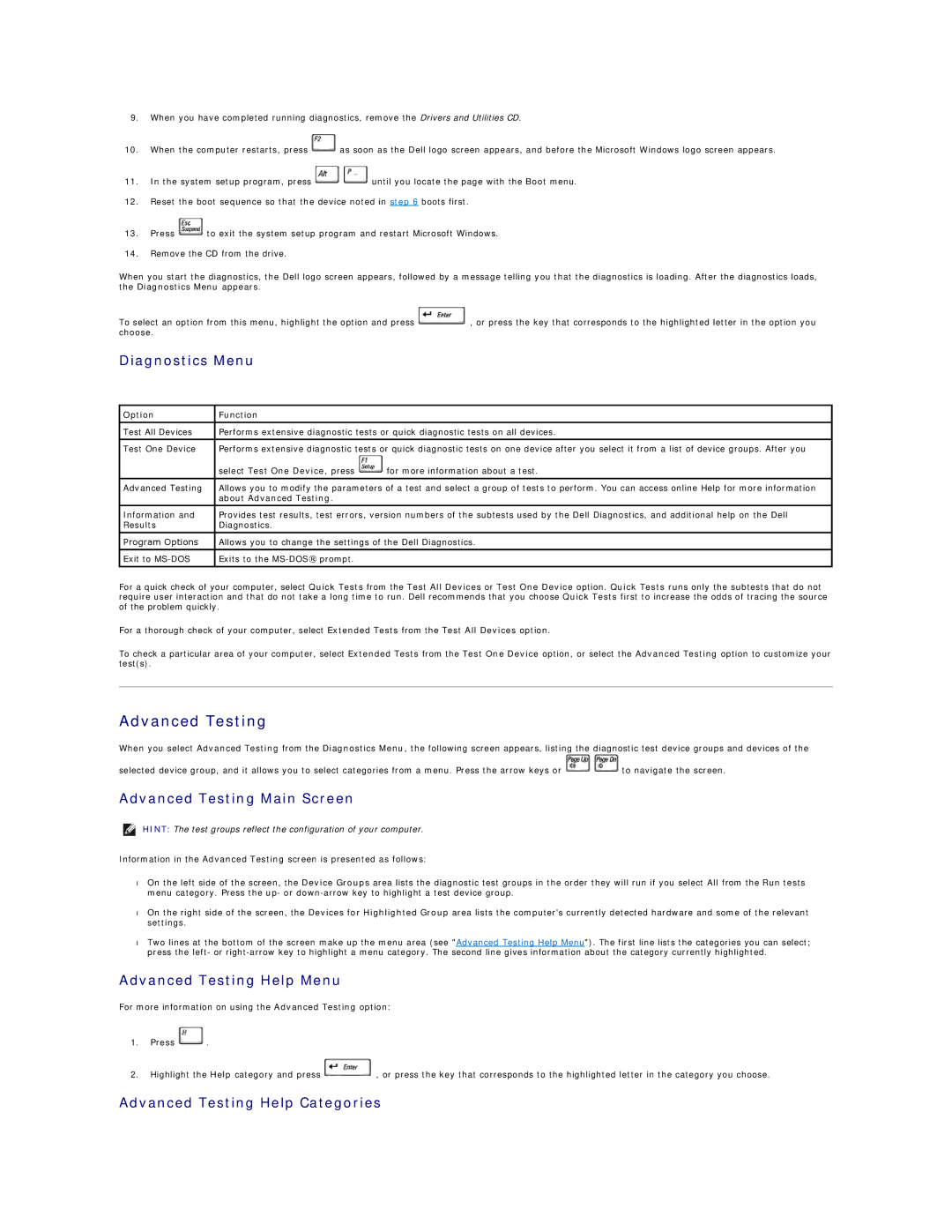
9.When you have completed running diagnostics, remove the Drivers and Utilities CD.
10.When the computer restarts, press ![]() as soon as the Dell logo screen appears, and before the Microsoft Windows logo screen appears.
as soon as the Dell logo screen appears, and before the Microsoft Windows logo screen appears.
11.In the system setup program, press ![]()
![]() until you locate the page with the Boot menu.
until you locate the page with the Boot menu.
12.Reset the boot sequence so that the device noted in step 6 boots first.
13.Press ![]() to exit the system setup program and restart Microsoft Windows.
to exit the system setup program and restart Microsoft Windows.
14.Remove the CD from the drive.
When you start the diagnostics, the Dell logo screen appears, followed by a message telling you that the diagnostics is loading. After the diagnostics loads, the Diagnostics Menu appears.
To select an option from this menu, highlight the option and press ![]() , or press the key that corresponds to the highlighted letter in the option you choose.
, or press the key that corresponds to the highlighted letter in the option you choose.
Diagnostics Menu
Option | Function |
|
|
| |
Test All Devices | Performs extensive diagnostic tests or quick diagnostic tests on all devices. | |
|
| |
Test One Device | Performs extensive diagnostic tests or quick diagnostic tests on one device after you select it from a list of device groups. After you | |
| select Test One Device, press | for more information about a test. |
|
| |
Advanced Testing | Allows you to modify the parameters of a test and select a group of tests to perform. You can access online Help for more information | |
| about Advanced Testing. |
|
|
| |
Information and | Provides test results, test errors, version numbers of the subtests used by the Dell Diagnostics, and additional help on the Dell | |
Results | Diagnostics. |
|
|
| |
Program Options | Allows you to change the settings of the Dell Diagnostics. | |
Exit to | Exits to the |
|
|
|
|
For a quick check of your computer, select Quick Tests from the Test All Devices or Test One Device option. Quick Tests runs only the subtests that do not require user interaction and that do not take a long time to run. Dell recommends that you choose Quick Tests first to increase the odds of tracing the source of the problem quickly.
For a thorough check of your computer, select Extended Tests from the Test All Devices option.
To check a particular area of your computer, select Extended Tests from the Test One Device option, or select the Advanced Testing option to customize your test(s).
Advanced Testing
When you select Advanced Testing from the Diagnostics Menu, the following screen appears, listing the diagnostic test device groups and devices of the
selected device group, and it allows you to select categories from a menu. Press the arrow keys or ![]()
![]() to navigate the screen.
to navigate the screen.
Advanced Testing Main Screen
HINT: The test groups reflect the configuration of your computer.
Information in the Advanced Testing screen is presented as follows:
•On the left side of the screen, the Device Groups area lists the diagnostic test groups in the order they will run if you select All from the Run tests menu category. Press the up- or
•On the right side of the screen, the Devices for Highlighted Group area lists the computer's currently detected hardware and some of the relevant settings.
•Two lines at the bottom of the screen make up the menu area (see "Advanced Testing Help Menu"). The first line lists the categories you can select; press the left- or
Advanced Testing Help Menu
For more information on using the Advanced Testing option:
1.Press ![]() .
.
2.Highlight the Help category and press ![]() , or press the key that corresponds to the highlighted letter in the category you choose.
, or press the key that corresponds to the highlighted letter in the category you choose.
